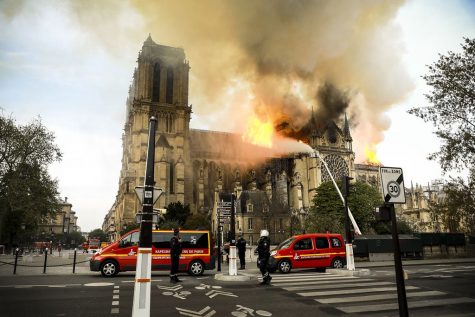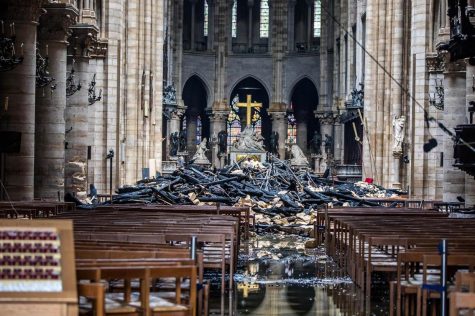Notre Dame Cathedral Burns in Paris, France

National monuments are a symbol of pride and honor. The people of France lost their most well-known monument—Notre Dame Cathedral—to a fire on April 15 and April 16.

The cathedral lost its 300-foot spire, the tapering conical structure on the top of the building, as well as its cross-like roof.
Fortunately, the cathedral’s two iconic stone bell towers and the basic stone structure of the building were saved.
According to The New York Times, the fire started in the cathedral’s attic, made entirely of ancient wood. When first inspected, a fire was not apparent. The attic was often referred to as “the forest” because of the amount of wood used to build it. The authorities were called only after the second fire alarm sounded and noticeable flames were seen. There was no stopping the fire once it started.
“[it was upsetting] seeing such a landmark of Western culture and the history that happened in there [Notre Dame] getting wiped clean into just contents of a charred-up building.” -Andrew Honold
During the fire, there was much concern over how many ancient relics were in Notre Dame and if they could be saved. The most popular artifacts, bringing the greatest concern, were the crown of thorns, which was supposedly worn by Jesus himself, and Saint Louis’ tunic. However, both were removed and transferred to Paris City Hall, according to The New York Times.
The cathedral’s famed organ was also, astonishingly, preserved in the blaze.
Senior Andrew Honold said he was emotionally affected by the news of the fire, especially because of all the years of history that the cathedral has seen.
“It was very tragic. The first thing I thought of was Napoleon being crowned emperor there. It’s so sad,” Honold said.

AP Government and Politics teacher, Mr. Walter Caskie, reacted to the news of the fire.
“I was really sad. I’ve been to Notre Dame, and it is a wonderful, beautiful piece of history, but it was very sad to see that it was destroyed.”
Honold said it was upsetting “seeing such a landmark of Western culture and the history that happened in there [Notre Dame] getting wiped clean into just contents of a charred-up building.”
According to The New York Times, the project to build Notre Dame began in 1163 and finished 182 years later in 1345.
“It is considered a jewel of medieval Gothic architecture,” Karen Zraick and Heather Murphy of The New York Times said.
“When you’re in the cathedral, you’re just awed,” Mr. Caskie said.
Given the significance of the cathedral, the destruction of Notre Dame will take a toll not only on France, but also the entirety of Western Europe, according to Honold.
“It really is a national landmark,” Mr. Caskie said. “Plus it’s got that link to religion, and I think that’s the piece—it’s more than just a building, and that’s why I think to them [the people of France] it’s like a national trainwreck.”
“It’s a huge event. It’s a defining event of French culture,” Honold said.
In terms of how this national disaster will affect the people of France, Honold believes that it will bring people closer together.
“It will be interesting to see how people react to it.”
“I think it will bring people closer together, especially with this great fundraising effort that has already happened to repair it,” Honold said.
Mr. Caskie agreed. “I think it’s going to bring people closer together in the fact that they’re going to have a cause: to rebuild it.”
The President of France, Emmanuel Macron, has pledged to have the cathedral rebuilt in five years. Some believe that this is an unrealistic expectation, especially considering how long it took to build originally, and how valuable the monument is to French culture.
Honold believes that committing to having the cathedral restored in five years is not a realistic expectation, expecting the restoration to last a decade or more.
“If they do it in five years, they’re not going to recapture the spirit that the cathedral once had,” Honold said. “They can’t rebuild the roof the way it was because there aren’t enough trees in France long enough to do that.”
“I think five years is an emotional reaction,” Mr. Caskie said. “That was a reaction that the president had to say—that we [the French government] are totally dedicated. We’re not going to have a committee and figure out what happened and why it happened. We’re going to start the process now.”
The cathedral had been damaged and deteriorating for years and underwent a “19th-century restoration,” according to TIME magazine.
“The medieval spire…was removed in 1786 because it wasn’t stable, then rebuilt during the 1860s, in a design conceived by Eugène-Emmanuel Viollet-le-Duc,” said TIME. “Even before the fire, the cathedral was already endangered by more ordinary damage.”
Given the magnitude of the cathedral’s importance in the lives of the French people, the French economy may be at risk.
“Every country should be aware and have empathy for anything like this, and I think a lot of countries have dedicated funds or dedicated services that would help to rebuild. I think that’s the diplomatic thing to do” -Mr. Caskie
“It might be more of an indirect effect, but when people see something as important as Notre Dame Cathedral burning down, that’s going to inspire uncertainty, fear, and maybe lack of trust in the government, and if people have those feelings, something’s going to inspire them to maybe hold onto their money because they feel like if this happens, maybe the entire banking system will collapse,” Honold said.
Mr. Caskie disagreed with Honold. “Because much of the money was donated, I’m not sure it’s going to hurt the economy. It’s probably going to help the local economy because it’s going to put a lot of people to work, and the French government’s not paying for it, so it could be good for the economy, particularly Paris.”
France is one of the 28 countries in the European Union (EU). In terms of support for France, it’s EU neighbors may be called upon to help.
“I think the right thing to do would be for countries in Europe and countries around the world to help France in that medium,” Honold said.
“Every country should be aware and have empathy for anything like this, and I think a lot of countries have dedicated funds or dedicated services that would help to rebuild. I think that’s the diplomatic thing to do,” Mr. Caskie said.
Mr. Caskie also furthered the point that even though this event did not happen locally, it cannot be ignored.
“It’s not an internal problem only. I think that anything a country can do diplomatically to help would be helpful.”
As of late May, the reason for the fire is unknown. There are multiple possible causes that have been mentioned such as a human error made from the ongoing renovations or an electrical issue that started in the cathedral’s spire, The New York Times reported.
“So far nothing was being ruled out and the investigation could last several weeks.”
“So far attention has focused on a number of electrical installations, but the police have also found cigarette butts on the scaffolding — a possible explanation for the blaze,” The New York Times said.
When the fire first began there was speculation that it might have been arson, especially due to the frequent recent terrorist attacks on Paris.
“If it was arson, I feel like that’s something that would have come out,” said Honold. “I feel like something as large of a scale as this, if someone was intentionally trying to burn it, it would have been a large operation, and I don’t think that’s what happened.”





